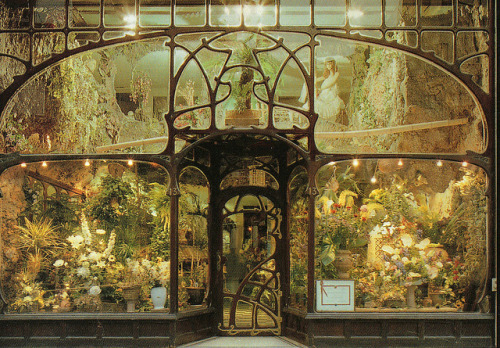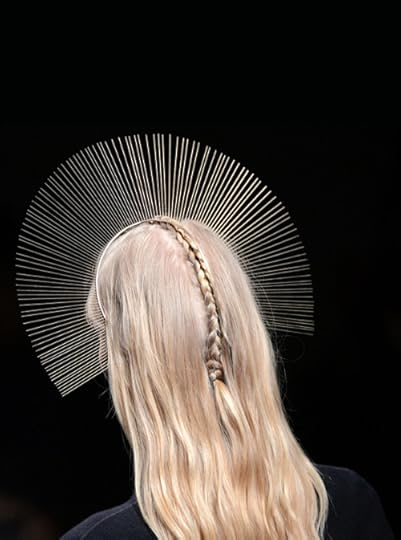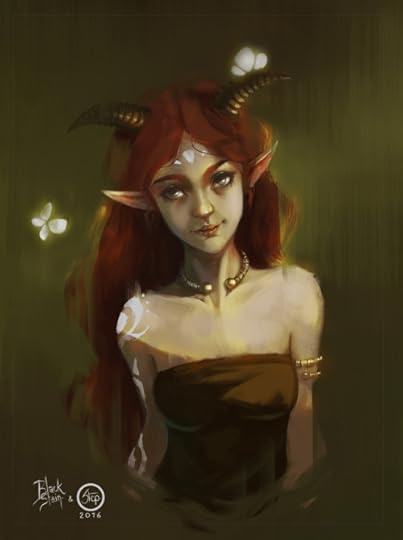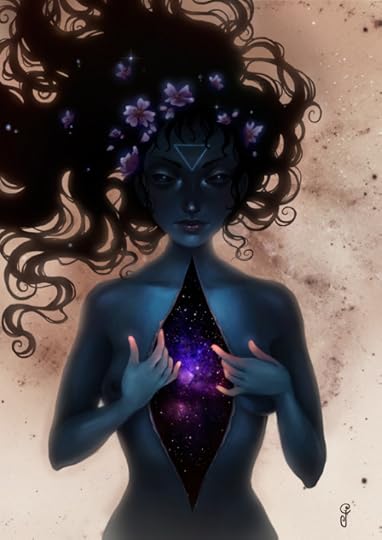Katherine Frances's Blog, page 231
May 8, 2016
May 7, 2016
grimogretricks:
Flower-shop, Brussels, designed by Paul Hankar,...

Flower-shop, Brussels, designed by Paul Hankar, XIX century.
This is literally the perfect, most fitting sort of thing to put in the window of an Art Nouveau front like this. One of the things I enjoyed about Brussels was the Art Nouveau architecture- not something you see in Britain much.
May 4, 2016
adedrizils-shrine:
Drujia by tranenlarm
wolftramp:
Vintage Blog
writing-questions-answered:
Anonymous asked:Is it okay to compare eye color to food and other...
Anonymous asked:
Is it okay to compare eye color to food and other things?
It really depends on what you’re using for comparison, but typically, food doesn’t make for a good comparison to eye color. For one thing, human eyes are amber, blue, brown, gray, green, hazel, and rarely red or violet. There aren’t a lot of foods that are those colors and would be appropriate comparisons. “Her eyes were as green as a leaf of Boston lettuce,” or “His eyes were as brown as the skin of a baking potato,” just doesn’t sound nice. Over fifty percent of the world has brown eyes, but the most obvious food to compare brown eyes to is chocolate, and that’s been done to death.
With food and with other objects, too, you have to worry not only about relevance (are your character’s eyes really the color of lapis lazuli? Probably not…), you also have to worry about any negative connotation the object might have. Dirt would be a poor choice, for example. Not only does dirt come in a variety of colors, it also has an unpleasant and unclean connotation, so probably not the best choice for eye color. “His eyes were brown like the bark of a tree,” is also not great. Like dirt, tree bark comes in a variety of colors, but it also has a rough and basic connotation. It also just sounds cheesy. On the other hand, “Her eyes were the color of spring’s first grass,” could be okay, especially if you want to imbue your character with all the positive qualities of springtime.
Also, it’s okay to just describe someone’s eye color as just brown or blue. Not every character is deserving of eyes the color of spring’s first grass. Reserve those descriptions for special moments–something that would be memorable for the character who is making the observation, or that need to have a huge impact on your reader. :)
————————————————————————————————
Have a writing question? I’d love to hear from you, but please be sure to read my ask rules and master list first or your question may go unanswered. :)
Writer Tool; Maps!
I’m pretty sure I’ve written about this before, but here it is again, the most useful tool when writing a story that takes place in a real world setting:
Google’s My MapsThe my maps app is supper useful. It gives you all the power of google maps, except hello you can edit it. Let me count the ways I love thee;
-Drop pins on locations, title them and write notes such as ‘Bobbie’s House- lived here 1995-1998′.
-Trace distances with the ruler. I use this function a lot to get ‘as the crow flies’ distance because there is a lot of helicopter travel in one of my books. You can also use it to to track on foot distances that you can’t get directions through, like if your character is walking through a national park.
-Save multiple maps for those of us who have multiple stories going on at once
-Save all your locations, and directions between locations if you like. Easy access to it at all times as long as you have internet
-One downfall, you can’t use the little man feature to drop down and look at a street view. But if you drop a pin on a building that has a formal address, a little window usually pops up with the info about it, and you can click a link that says ‘view in google maps’ which will allow you to see the street view.
-I use it in tandem with Google maps so I can easily use street view and get info on buildings, then copy the address and pop it over into my maps and save it there.
-It’s also free, that’s a no brainier right there.
-Helps you write about places you’ve never been
-It’s basically saved my continuity bacon, and I’m sure it could do the same for you.
So in conclusion, GET TO IT :)
May 3, 2016
adedrizils-shrine:
Not young Easther by SineAlas
Writer Tool; Maps!
I’m pretty sure I’ve written about this before, but here it is again, the most useful tool when writing a story that takes place in a real world setting:
Google’s My MapsThe my maps app is supper useful. It gives you all the power of google maps, except hello you can edit it. Let me count the ways I love thee;
-Drop pins on locations, title them and write notes such as ‘Bobbie’s House- lived here 1995-1998′.
-Trace distances with the ruler. I use this function a lot to get ‘as the crow flies’ distance because there is a lot of helicopter travel in one of my books. You can also use it to to track on foot distances that you can’t get directions through, like if your character is walking through a national park.
-Save multiple maps for those of us who have multiple stories going on at once
-Save all your locations, and directions between locations if you like. Easy access to it at all times as long as you have internet
-One downfall, you can’t use the little man feature to drop down and look at a street view. But if you drop a pin on a building that has a formal address, a little window usually pops up with the info about it, and you can click a link that says ‘view in google maps’ which will allow you to see the street view.
-I use it in tandem with Google maps so I can easily use street view and get info on buildings, then copy the address and pop it over into my maps and save it there.
-It’s also free, that’s a no brainier right there.
-Helps you write about places you’ve never been
-It’s basically saved my continuity bacon, and I’m sure it could do the same for you.
So in conclusion, GET TO IT :)









